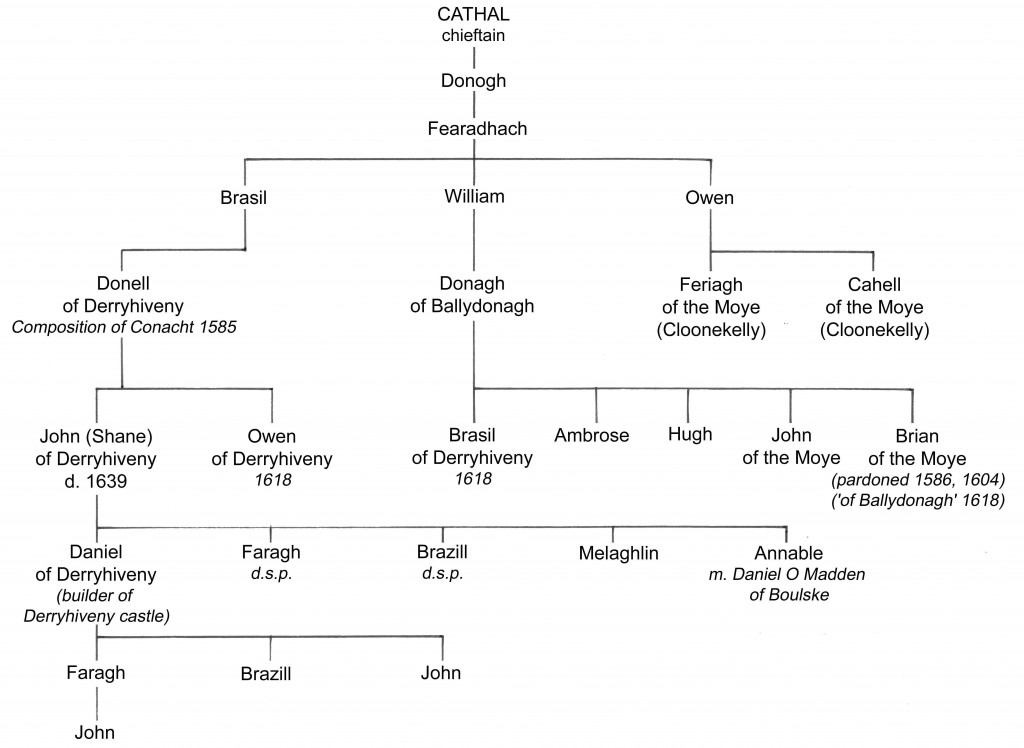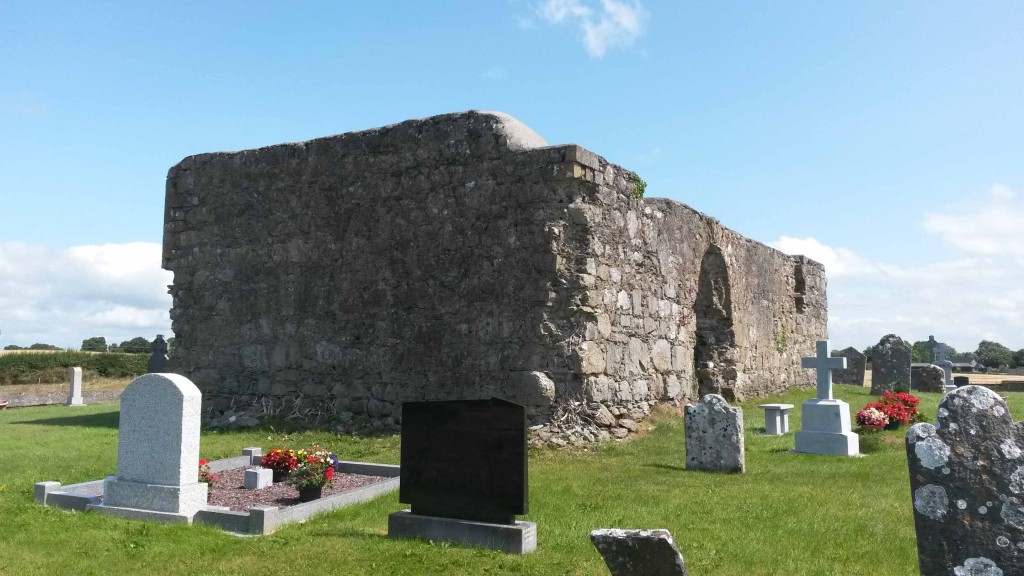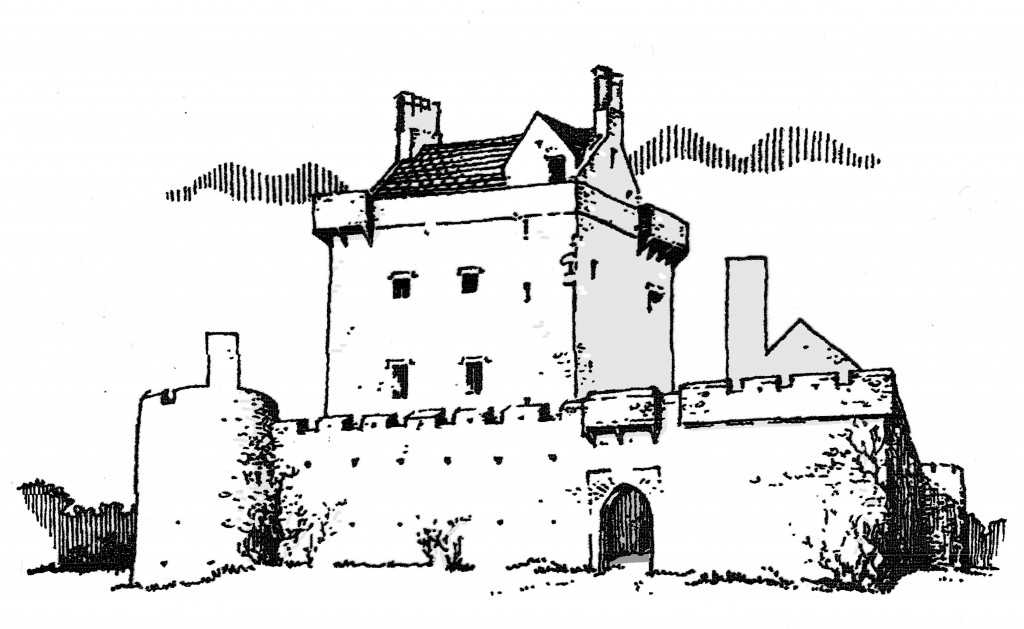© Donal G. Burke 2013
The O Maddens of Derryhiveny were the descendents of one identified as Farriagh (given in various records relating to his descendants as ‘Farragh’, ‘Arre’ or ‘Karrye’) O Madden, an anglicization of the Gaelic Christian name Fearadhach. The progeny of Farriagh O Madden were established as landholders in both the parishes of Kilmalinoge and Kilquain in the late sixteenth century. Farriagh was described as ‘son of Donogh son of Cathal O Madden of Longford alias Derryhewny, chief of his tribe.’[i] This Cathal appears in a pedigree of his wider family as ‘Charles O Madden of Derryhewny or Longford, gentleman,’ junior brother of Morogh reagh O Madden and son of Owen carrach O Madden, son of Morogh O Madden (the reputed patron of the building of Meelick friary) son of Owen mór O Madden son of Morogh O Madden, son of Owen O Madden son of Morogh son of Cathal son of Madagan mór.[ii] This family group apparently last held the chieftaincy of the territory some time in the late fifteenth century. By the late sixteenth century this group were distanced from the office by several generations but formed an important constituent sub-sept, the senior line of which resided in the south of the lordship of Síl Anmchadha, at Derryhiveny in the parish of Kilmalinoge.
Members of the senior line of Derryhiveny
O’Ferrall’s ‘Linea Antiqua’ of 1709 mentions only one son of Farriagh son of Donogh, that is, Breasal. However, evidence suggests that Farriagh son of Donogh had at least two other sons, William and Owen, with the senior line descended from Breasal. This senior line was represented at the 1585 Indenture of O Madden’s Country by Daniel or Domhnall macBreasail macFarriagh of Derryhiveny. The junior lines of William and Owen for the most part resided in an area known variously as ‘the Moey’ or ‘the Moveffe’, located in the parish of Kilquain and more specifically about the half quarter of Cloonekellogh in that parish. It is possible that the Donogh mcWilliam of Balledonagh[iii] who was a participant in the 1585 ‘Composition of Connacht’ Indenture relating to the territory of Síl Anmchadha (or the barony of Longford) represented the junior branch of William.[iv]
Members of a junior line
Of this junior line, Donogh McWilliam McKarrye (recte: Farragh) of Moey, gentleman, was among a number of men of the territory pardoned by the Crown alongside Conor O Horan of Fahy, the head of that family about 1570-71.[v] More than a decade later, Ferreagh mcOen Mc Arre (recte: Farriagh) of Moye was one among many of Síl Anmchadha issued a pardon in 1586.[vi] In 1604 Shane McDonnogh of the Moveffe (Moey or ‘Maigh’, the plain), yeoman, Brian McDonnogh of the same place, gentleman and Farriagh McOwen of the Moveffe, yeoman, were among those issued a pardon by the new king, James I. This Shane McDonnogh of the Moveffe appears to be the same man described about 1618 as ‘John McDonogh O Madden of Cloonekilly, gentleman’ holding lands in that year in Cloonekilly, Cullemulline and Kile in Longford barony, while that same year Ferragh McOwin O Madden and one Cahell McOwin O Madden of Cloonekelly, gentlemen, apparently brothers, jointly held lands again in Cloonekilly, Cullemulline and Kille.[vii]
This Cloonekilly (also given as Cloonekelly and Cloonekellogh in seventeenth century sources) appears to be the area known in the modern period as Cloonkela, a local place-name within the townland of Muingbaun in the southern end of the parish of Kilquain, near Kilmalinoge. This would suggest that ‘the Moveffe’ or ‘Moye’ was located in the south of Kilquain parish about Muingbaun.
It is noteworthy that the head of the family group, John McDonnell McBrazill O Madden of Derrisureine (recte: Derryhiveny) in 1618 held, in addition to his lands in Derryswiny, Care (later townland of Corr), Cappaghbeg, lands in Keile (the quarter of Kill alias Killtirebrack in the parish of Tiranascragh) and Cullemulline. Similarly, Hugh McDowny O Madden of Derrysuyny also held a small portion of lands in both Derryhiveny and Cullemulline.[viii] It is also noteworthy that both Shane or John McDonogh and Farriagh McOwen are both described as of ‘the Moye’ and of Cloonekilly.
In April of 1604 Owen Mc Donnell Mc Brasell of Derryhenny and Shane Mc Donell of the same, gentlemen, were among those granted a general pardon in that year.[ix] The former appears to be the same man as Owen McDonnell O Madden of Derryswiney who, jointly with Brazell McDowny O Madden of Derryswiney, held a small portion of Cloonkillie in the parish of Kilquain and who in their own right each held separately another portion in that denomination and a portion of Derryswiney (recte: Derryhiveny) about 1618.
Landholders in the mid Seventeenth Century
Donell (or Daniel) son of Brasil was succeeded by his son John, who married Fenola, daughter of Conor O Horan of Fahy, ‘chief of his name.’[x] On the 5th February 1639 John died and was buried in the nearby church of Kilmalinoge.[xi] He would appear to be the same man as that individual who had a chalice presented to Portumna convent in 1644 inscribed with the name of ‘Joannes Madyn de Deriheuny’ which may have been presented to comply with the last wishes of this John.[xii] He had four sons and one daughter; Daniel, Faragh, Brazill, Melaghlin and Annable. He was succeeded by his eldest son Daniel and, of his other offspring, both Faragh and Brazill died without issue, while Melaghlin was living in the mid to late seventeenth century and Annable married Daniel O Madden of Boluske, whose lands lay nearby, primarily in the half parish of Tynagh that lay within the barony of Longford.
The ruins of the late medieval church at Kilmalinoge, burial place of John O Madden of Derryhiveny who died in 1639.
John’s eldest son Daniel of Derryhiveny (also known as Daniel McShane O Madden), the senior-most member of the wider family group in the mid seventeenth century, married Evelyn, the daughter of Kyvas Tully of Garbally, Protestant dean of Clonfert.[xiii] The bulk of the lands of Daniel of Derryhiveny about 1640 lay within the parish of Killmalinoge, with smaller parcels in the neighbouring parishes of Tiranascragh, Kilquain and Killimorbologue. He was sufficiently wealthy to have a tower house and bawn erected as his principal residence at Derryhiveny in or about 1643, one of the last of its kind built in the country, its reliance on traditional defensive features common to former tower house architecture reflective of the political turmoil of that period. By his wife Evelyn, Daniel O Madden had three sons; Faragh, Brazill and John, the eldest of whom, Fariagh had at least one son John O Madden.[xiv]
Conjectural sketch of Derryhiveny castle and bawn, after H. G. Leask.
Cromwellian Period
With the prospect of fresh land confiscations and colonisation looming large in the background and unable to depend on an unreliable monarch or an increasingly powerful anti-Roman Catholic English Parliament for satisfaction, several of the Ulster Roman Catholic land-owners took advantage of the divisions between the King and English parliamentarians and in 1641 rose up in arms against the colonists. The leading rebels claimed as justification for their actions that they were rising out in support of the King, in his struggle with an English parliament determined to divest him of his powers. As the Ulster rebels, composed mostly of the Gaelic aristocratic families, claimed to be acting in the interest of the Crown, the old Anglo-Norman families or the Old English, found themselves on the same side as the Gaelic lords, facing a common enemy. Many of the Old English joined the insurgents and the rebellion met with considerable initial success.
One Captain Hugh Madden of Glovedagene, County Galway appears to have been held a commission in the Irish army during the Civil War that ensued following the 1641 Insurrection. The identity of this Hugh is unclear but he was closely connected with the Derryhiveny family. His death occurred before October 1658 as in that month the administration of his goods was granted in to Daniel of Derryhiveny as his next of kin.[xv]
Cromwellian dispossessions
The senior line lost possession of their lands about Derryhiveny as a result of the Cromwellian confiscations and transplantations in the mid seventeenth century. Much of the lands of Kilmalinoge were reserved for Henry, son of Oliver Cromwell, as part of a large estate along the Shannon from the parish of Lickmolassy to Clonfert and included the Earl of Clanricarde’s seat at Portumna, resulting in the confiscation of O Madden’s ancestral lands about Derryhiveny as part of that estate.[xvi] Daniel O Madden of Derryhiveny was allocated 765 profitable Irish acres elsewhere in the same barony, in the parishes of Abbeygormacan, Killoran and Kiltormer.[xvii] The same man was given as head of family and one of the dispossessed landowners in 1664 whose lands was confiscated by the Cromwellian authorities and whose names were submitted to the Lord Lieutenant in that year for consideration for reinstatement.[xviii]
Another O Madden, one Farragh McBrassil Madden ‘of Derryherony’ was likewise ordered to transplant and allocated sixty-two profitable Irish acres in the parishes of Killimorbologue and Kiltormer.[xix] This individual does not occur among the landholders of the sept about 1640, but as he was described as of Derryhiveny, he may have been a son of Brassell Mc Donogh O Madden, who held a portion of commonage in Derryhiveny and in Cloonekellogh about 1640.[xx] No other Brassell held lands at that time in either the parishes of Kilmalinoge, Tiranascragh, Kilquain or Killimorbologue and he may have been a member of a junior line of the sept descended from Donagh son of William son of Ferriagh and therefore a distant kinsman of Daniel of Derryhiveny.
Restoration of the Crown and the Act of Settlement
Following the turmoil of that period and the restoration of the monarchy in the person of King Charles II in 1660, an Act of Settlement was passed in Parliament, in an attempt to address the complaints of those whose lands had been taken or divided by the Cromwellians and to placate those who had acquired lands at that time.
Henry Cromwell had a number of influential friends whose support ensured that a special clause was included in the Act of Settlement to preserve for him the greater part of his Irish estates along the Shannon. The Earls of Clanricarde regained their Portumna lands but the O Maddens of Derryhiveny and the O Cormicans failed to regain ownership of their former property.[xxi] Cromwell sold his Irish lands, which were purchased thereafter by the Earls of Cork and Arran.
These lands were subsequently sold in 1717 by Lady Burlington and Cork to a London merchant, Benjamin Gascoigne.[xxii] The lands about Kilmalinoge were sold in 1749 to one Theobald Wolfe, through the marriage of whose daughter those lands came into the possession of the Fetherston family. Part of the lands formerly held by the O Maddens were leased to others while later members of the Fetherston family came to settle about Derryhiveny. [xxiii]
[i] N.L.I., Dublin, G.O., Ms. 71, Funeral Entries, p. 310. The reference to Longford here would appear to relate to its position as a chiefry castle and the residence of the chieftain during his term of office.
[ii] N.L.I., Dublin, G.O., Ms. 146, Linea Antiqua (Betham), p. 272, 298, 299; G.O. Ms. 155 O’Ferrals’ Linea Antiqua 1709, p 171.
[iii] This Ballydonagh appears to have been in Kilquain parish and not that Ballydonagh situated in the parish of Kiltormer. Donagh’s son, Brian mcDonagh was described as of ‘the Moveffe’ in a pardon of 1604 and of Ballymcdonagh in 1619. (Cal. Patent Rolls James I) Brian’s 1619 lands comprised of one third of a cartron of Feagh and one twenty fourth of the four quarters of Moigh.
[iv] Brasil McDonagh O Madden with ¼ of ½ cartron of the ½ quarter of Cloonekellogh in Kilquain immediately prior to 1641 appears to be the same man as Brasil McDowny of Derryswiney (Derryhiveny). Brasil mcDowny O Madden of Derryswiney held ½ cartron of Cloonkellie alongside Owen McDonnell O Madden of Derryswiney in 1619. (Cal. Patent Rolls, 16 James I, p. 415.)
[v] Fiants Eliz. I., 22 March XIII.
[vi] Fiants Eliz I.
[vii] Cal. Patent Rolls, 16 James I, pp. 415-6.
[viii] Cal. Patent Rolls, 16 James I, p. 416. This Hugh appears to be the same man as ‘Hugh McDownowagh O Madden of Garrigrower in Co. Galway’ who held lands at Derryswyny, Carrinagreiver and elsewhere in 1614 but conveyed the ownership of the same that year to Edmund Burke of Kilcornan, kinsman of the Earl of Clanricarde. (RC 5/29 Transcripts of Deeds and Wills recited in Inquisitions (Chancery), p. 94, no. 39.)
[ix] Calendar of the Patent Rolls of the Chancery of Ireland, 1800, 2 James I, p. 45.
[x] N.L.I., Dublin, G.O., Ms. 146, Linea Antiqua (Betham), p. 272, 298, 299.
[xi] N.L.I., Dublin, G.O., Ms. 146, Linea Antiqua (Betham), p. 272, 298, 299.
[xii] Egan, Rev. P.K., ‘Clonfert Museum’, J.G.A.H.S., Vol. XXVII, 1956-7, p. 47. The chalice was later presented to Clonfert Museum, Loughrea. Inscribed on the foot of the chalice was ‘Joanes Madyn de Deriheuny Moriens me fieri iussit pro Conventu portumnensi 1644.’
[xiii] N.L.I., Dublin, G.O., Ms. 146, Linea Antiqua (Betham), p. 272, 298, 299.
[xiv] N.L.I., Dublin, G.O., Ms. 146, Linea Antiqua (Betham), p. 272, 298, 299.
[xv] N.L.I., Dublin, G.O., Ms. 139.
[xvi] MacGiolla Choille, B. (ed.), Books of Survey and Distribution, Vol. III, County of Galway, Dublin, Stationary Office for the I.M.C., 1962, pp. xlvii, 180-2; Simington, R.C., The Transplantation to Connacht 1654-58, Shannon, Irish University Press, for the I.M.C., 1970, p. 161.
[xvii] Simington, R.C., The Transplantation to Connacht 1654-58, Shannon, Irish University Press, for the I.M.C., 1970, p. 159.
[xviii] The Irish Genealogist, Vol. 4, p. 275.
[xix] Simington, R.C., The Transplantation to Connacht 1654-58, Shannon, Irish University Press, for the I.M.C., 1970, p. 159.
[xx] MacGiolla Choille, B. (ed.), Books of Survey and Distribution, Vol. III, County of Galway, Dublin, Stationary Office for the I.M.C., 1962, pp. 178, 181.
[xxi] MacGiolla Choille, B. (ed.), Books of Survey and Distribution, Vol. III, County of Galway, Dublin, Stationary Office for the I.M.C., 1962, pp. xlvii, 180-2.
[xxii] Melvin, P., Estates and Landed Society in Galway, Dublin, Edmund Burke Publisher, 2012, pp. 47, 64.
[xxiii] Melvin, P., Estates and Landed Society in Galway, Dublin, Edmund Burke Publisher, 2012, pp. 47, 64.




